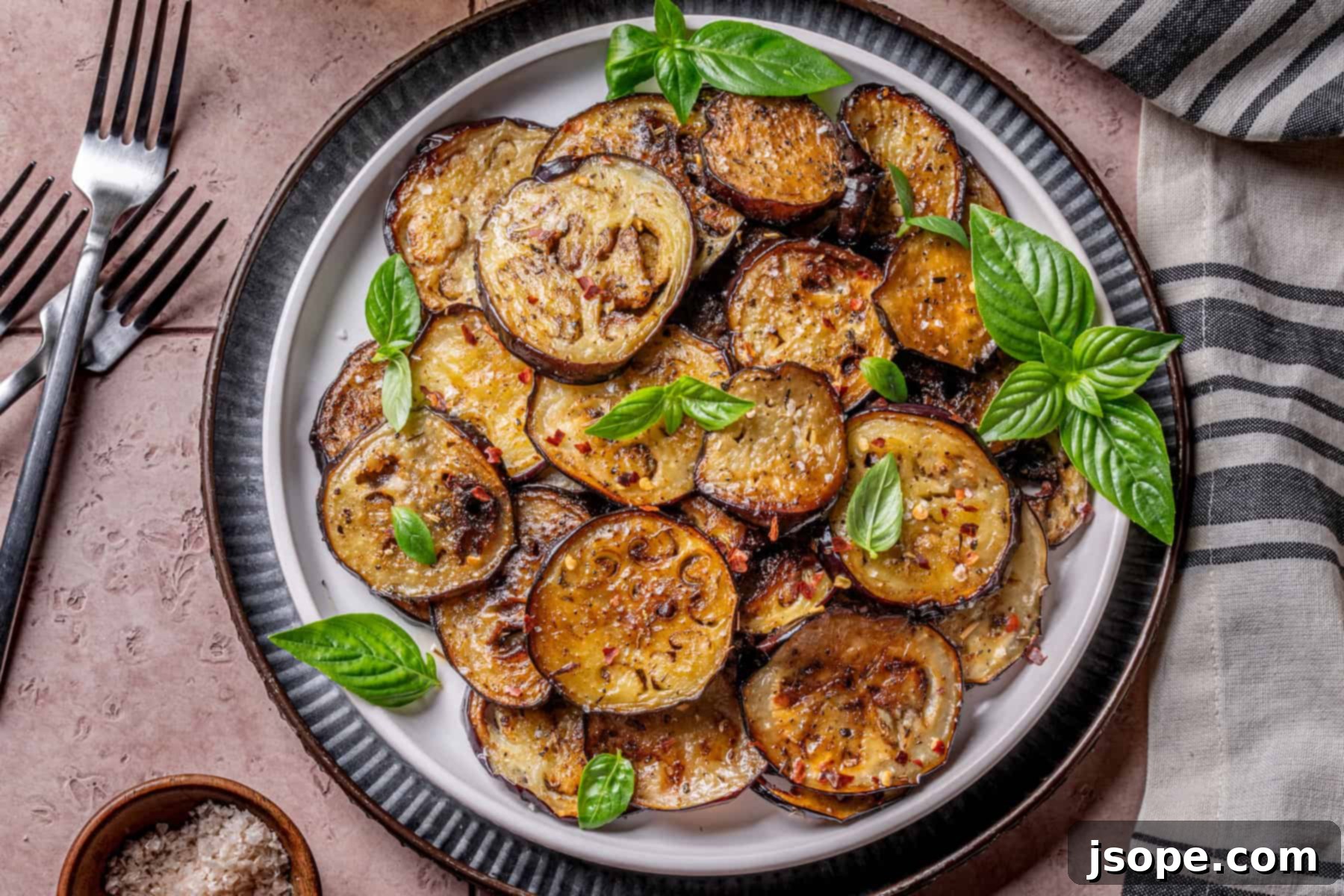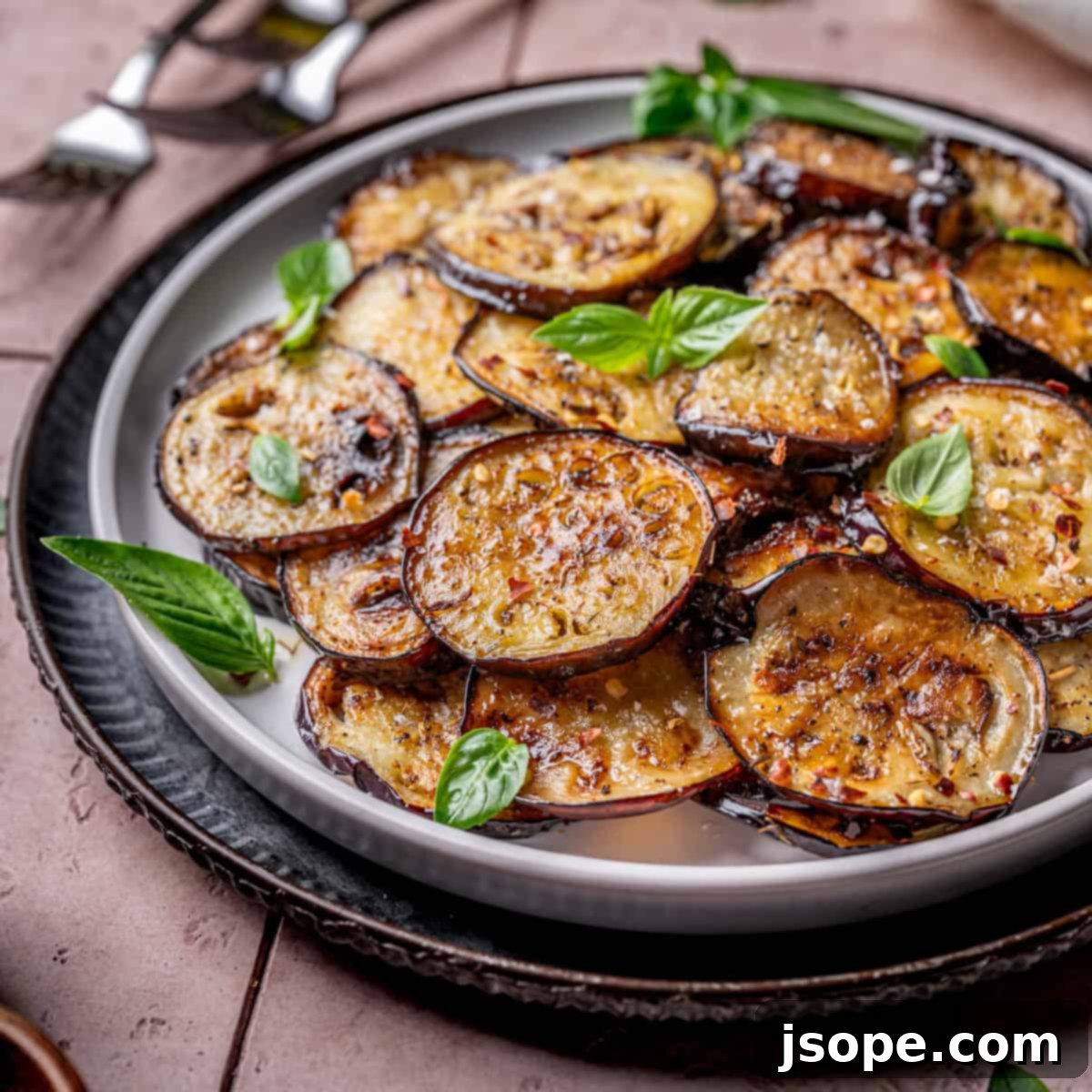Simple yet profoundly flavorful vegetables are a culinary cornerstone, cherished across countless cuisines worldwide. Among them, this rendition of Sautéed Italian Eggplant stands out as an absolutely delicious and remarkably easy-to-prepare dish. While botanically a fruit, eggplant is universally embraced in the culinary world as a versatile vegetable, offering a unique texture and absorbing flavors beautifully. This recipe boasts an effortless preparation, coming together in under 15 minutes – perfect for busy weeknights or as an elegant addition to any meal.
Eggplant might not always top the list of most popular vegetable side dishes for everyone, but a simple sauté in good quality olive oil, infused with classic dried Italian herbs and aromatic garlic powder, transforms fresh eggplant slices into a creamy, tender, and incredibly flavorful delight. This method unlocks the eggplant’s inherent sweetness and creates a wonderful caramelized exterior, making it an irresistible accompaniment to a wide range of main courses.
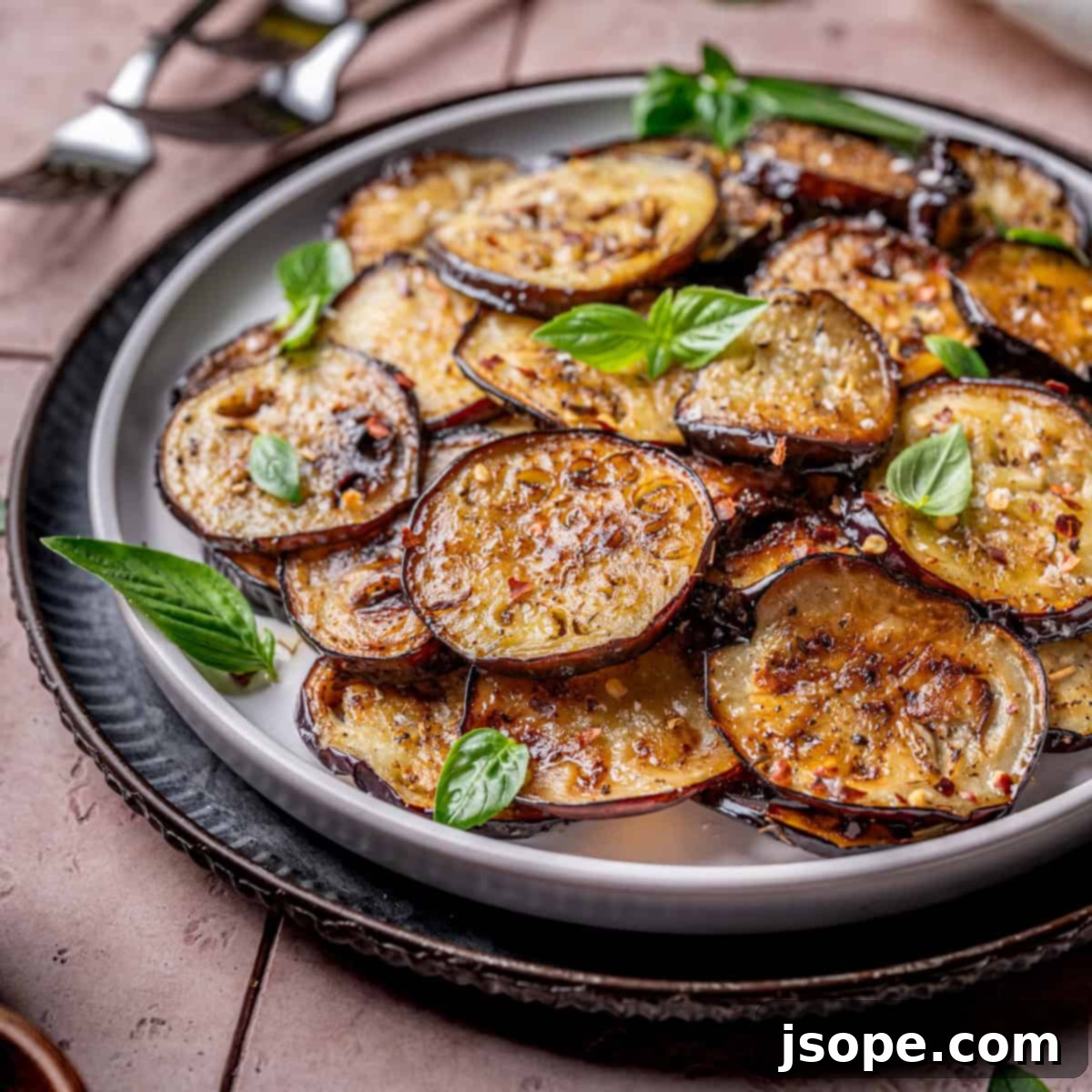
For those eager to explore more vibrant and healthy vegetable dishes, we highly recommend trying our Italian White Beans with Kale and Tomatoes for a hearty and nutritious meal, or the fiery kick of our Spicy Charred Calabrian Chili Broccolini for an adventurous side. Each offers a distinct flavor profile that complements various main dishes.
Why You’ll Love This Sautéed Eggplant Recipe
- Effortless Preparation: This recipe offers an incredibly easy and quick way to prepare eggplant, making it a fantastic choice for everyday meals without compromising on gourmet flavor.
- Remarkably Healthy: Eggplant is a powerhouse of nutrients, known for being rich in fiber, vitamins, and antioxidants. It’s a healthy addition to any diet.
- Exquisite Flavor & Texture: Experience the delightful combination of savory Italian herbs and garlic perfectly complementing the creamy, tender interior and delicately caramelized exterior of the eggplant.
- Highly Customizable: This versatile eggplant side dish can be easily adapted to your personal taste, allowing for creative seasoning variations or additions.
- Versatile Side Dish: Its balanced flavor profile and appealing texture mean it pairs wonderfully with a vast array of main courses, from grilled meats to pasta dishes.
Eggplant’s Prominent Place in Italian Cuisine
Eggplant, or ‘melanzane’ as it’s known in Italy, holds a revered position in Italian cooking, much like it does across the entire Mediterranean region. Its popularity stems from its incredible versatility and ability to absorb and enhance the flavors of other ingredients, making it a staple in many iconic dishes.
Beyond the globally acclaimed Eggplant Parmesan (Melanzane alla Parmigiana), where layers of fried or baked eggplant, tomato sauce, mozzarella, and Parmesan cheese create a rich, comforting casserole, numerous other beloved Italian dishes feature this incredible nightshade. Consider Pasta alla Norma, a classic Sicilian spaghetti dish where sautéed eggplant, ripe tomatoes, and aged ricotta salata come together in a symphony of flavors. Eggplant Rollatini, where thin slices of eggplant are rolled around a creamy ricotta filling and baked in marinara sauce, offers another popular and delicious use. Stuffed and baked eggplants, often filled with a mixture of breadcrumbs, cheese, and herbs, also showcase the vegetable’s ability to be a hearty and satisfying main or side. Throughout Italy, you’ll discover countless regional variations of sautéed, grilled, or roasted eggplant, each highlighting its unique qualities in simple yet profound ways.
For this specific recipe, our intention was to celebrate the eggplant in its purest form, allowing its natural flavor and creamy texture to shine. By simply sautéing thin slices with a thoughtful blend of seasonings, we bring forth an easy and exceptionally delicious dish that epitomizes the elegance of Italian simplicity.
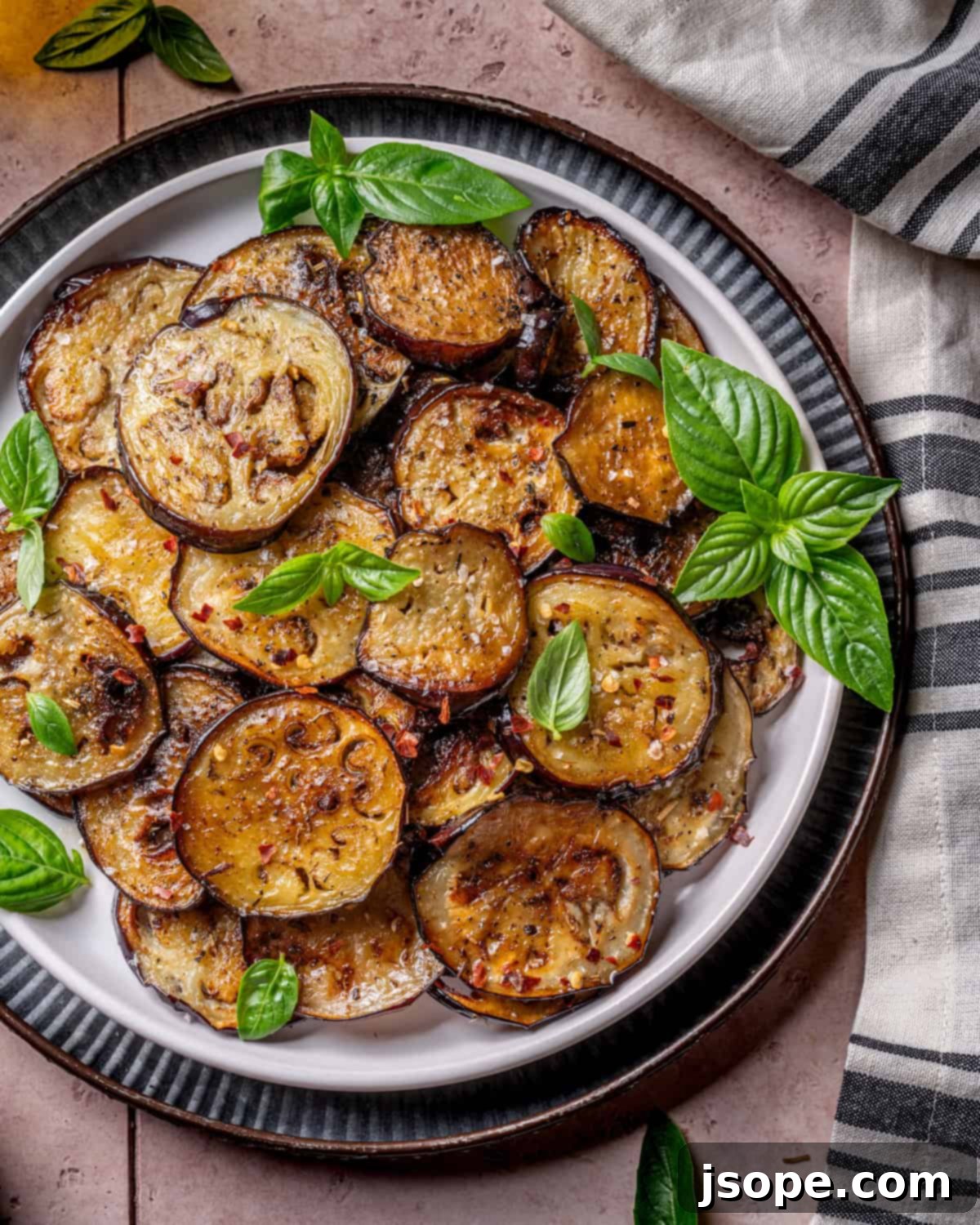
Ingredients You’ll Need for This Simple Eggplant Recipe
Crafting this flavorful eggplant dish requires only a few quality ingredients, easily found at any grocery store:
- Eggplant: The star of our dish. There’s a wonderful diversity of eggplant varieties, and not all are ideal for this preparation. We specifically recommend using Italian eggplant. These are typically smaller globe-shaped eggplants, characterized by their deep purple or nearly black skin, often without stripes or other distinct coloring. Italian eggplants are generally medium to small in size, and for this recipe, smaller eggplants are truly superior. They tend to have fewer seeds, a sweeter flavor, and a less bitter taste, contributing to a more tender and creamy final product.
- Olive Oil: A cornerstone of Mediterranean cooking, extra virgin olive oil is essential for sautéing the eggplant. Its fruity notes complement the eggplant beautifully and help achieve that desirable golden caramelization.
- Kosher Salt & Black Pepper: Fundamental seasonings to enhance and balance the natural flavors of the eggplant. We use kosher salt for its texture and consistent seasoning.
- Italian Seasoning: A versatile blend of dried herbs that is a must-have for any Italian-inspired dish. Typically, this blend combines oregano, basil, thyme, rosemary, and marjoram, offering a complex yet harmonious aromatic profile. Choose your favorite brand for the best results.
- Garlic Powder: For a quick and evenly distributed garlic flavor without the fuss of mincing fresh cloves. Ensure you use garlic powder, not garlic salt, to control the overall sodium content.
- Sea Salt (Flaky): Optional, but highly recommended as a finishing touch. A sprinkle of flaky sea salt over the freshly sautéed eggplant adds a delightful textural contrast and a burst of clean, briny flavor.
- Fresh Basil Leaves: Used as a garnish, fresh basil provides a vibrant pop of color and an aromatic, peppery sweetness that brightens the entire dish.
Please refer to the complete recipe card below for precise quantities and full detailed instructions.
Versatile Substitutions for This Easy Recipe
This simple eggplant recipe is quite forgiving and allows for several common substitutions to tailor it to your pantry or taste preferences:
- Italian Seasoning Alternatives: Feel free to experiment with different seasoning blends to change the flavor profile. Consider a Mediterranean herb mix (with more oregano and mint), Herbs de Provence, or even a simple combination of dried oregano and thyme. For a different global twist, a pinch of smoked paprika and cumin could take it in a Spanish direction, or a touch of curry powder for an Indian-inspired side.
- Garlic Powder Options: While garlic powder is incredibly convenient, you can easily substitute it with onion powder for a milder, sweeter allium flavor, or even use both! For those who prefer fresh ingredients and have a little extra time, 2-3 cloves of finely minced fresh garlic can be used. Add it to the pan during the last minute of sautéing to prevent burning, ensuring it softens and becomes fragrant.
Mastering Sautéed Italian Eggplant: A Simple Technique
Creating this delicious Italian sautéed eggplant recipe requires minimal time and effort, making it an ideal choice for any home cook. The process is wonderfully straightforward: begin by uniformly slicing the eggplant, then gently sauté the pieces in hot olive oil, seasoning them generously as they cook. The magic happens quickly as the eggplant pan-fries, developing a beautiful caramelization on the exterior while transforming into a lusciously tender, creamy texture within. Once each slice reaches this perfect state of tenderness and golden-brown perfection, your flavorful side dish is ready to be enjoyed.
Essential Equipment for This Dish
You only need one key piece of kitchen equipment to bring this recipe to life:
- Large Frying Pan: A generously sized frying pan or skillet (preferably cast iron or heavy-bottomed stainless steel) is crucial. A large surface area allows you to sauté the eggplant in fewer batches, ensuring even cooking and optimal caramelization without overcrowding, which can lead to steaming rather than browning.
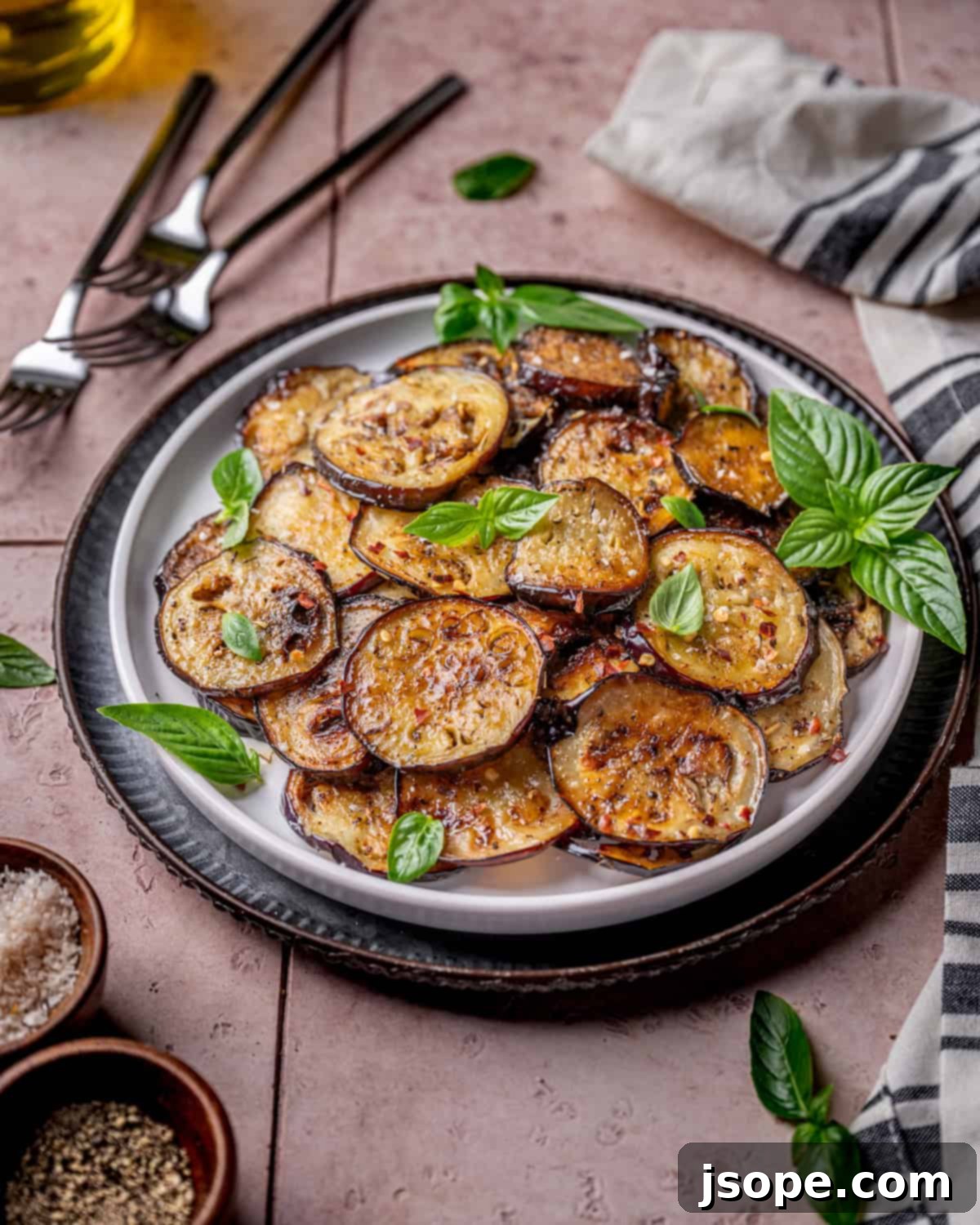
Step-by-Step Guide to Perfect Sautéed Italian Eggplant
1. Prepare the Eggplant for Sautéing
- Begin by washing the eggplants thoroughly. Carefully remove the tough green stem and the very top portion of each eggplant. Next, slice the eggplants into uniform rounds. For optimal cooking, we highly recommend aiming for a thickness of ¼ inch. This specific thickness ensures that the eggplant slices cook perfectly: they will develop a desirable caramelized, golden-brown exterior while maintaining a wonderfully creamy and tender interior, creating a delightful contrast in texture with every bite. If you prefer, you can also slice them into half-moons by cutting the rounds in half.
2. Sauté and Season the Eggplant to Perfection
- Place your large frying pan over medium-high heat. Add approximately 3 tablespoons of olive oil to the pan. Allow the oil to heat up sufficiently until it shimmers but isn’t smoking. Once hot, begin sautéing the eggplant in batches to avoid overcrowding the pan. Lay a single layer of eggplant rounds in the hot oil. Immediately season the exposed top side of the eggplant with a light sprinkle of kosher salt, black pepper, Italian seasoning, and garlic powder. Cook for a few minutes until the underside develops a deep golden-brown, caramelized color. Flip each slice and season the second side in the same manner. Each side will typically take only 2-3 minutes to cook through.
- As each batch of eggplant exteriors achieves that beautiful, deep caramel color and the interior becomes tender, carefully remove them to a serving plate. If desired, sprinkle a pinch of flaky sea salt on top for an extra layer of flavor and texture. To keep the finished batches warm while you complete the remaining eggplant, you can transfer them to an oven preheated to 250°F (120°C). Remember that eggplant is highly absorbent, so as you work through subsequent batches, you may need to add a little more olive oil to the pan to maintain consistent cooking. Serve immediately and enjoy!
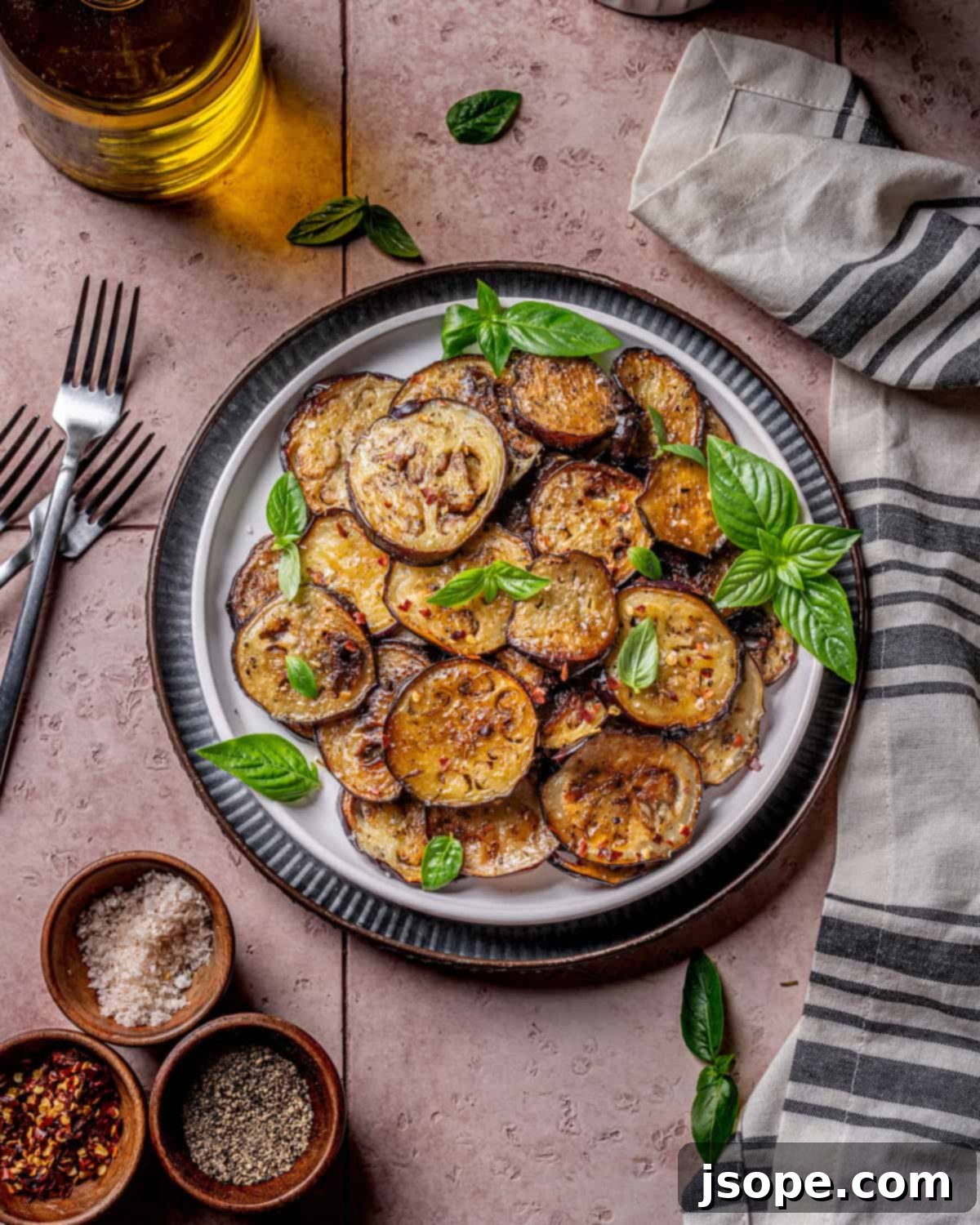
Creative Variations for This Recipe
This basic sautéed eggplant recipe is an excellent foundation for culinary experimentation. Here are a couple of ways to easily change up the dish:
- Serve with a Light Tomato Sauce: Transform this simple side into a more substantial offering by gently simmering the sautéed eggplant in a delicate tomato sauce. This creates a comforting dish that pairs beautifully with rice, your favorite pasta, or alongside other steamed or roasted vegetables. A sprinkle of fresh parsley or grated Parmesan cheese would be a perfect finishing touch.
- Infuse with Spicy Heat: For those who appreciate a little kick, consider adding some crushed red pepper flakes to the pan along with the other seasonings. A ¼ to ½ teaspoon, depending on your heat preference, will introduce a pleasant warmth that enhances the savory flavors of the eggplant without overpowering them.
- Herb Variation: Instead of Italian seasoning, try a blend of fresh herbs like finely chopped parsley, mint, and oregano after cooking for a brighter, fresher flavor.
- Balsamic Glaze: Drizzle a reduction of balsamic vinegar over the finished eggplant for a sweet and tangy contrast that elevates the dish.
Storage Best Practices for Sautéed Eggplant
Proper storage ensures you can enjoy your delicious sautéed eggplant for days:
- How to Store Leftover Sautéed Eggplant: Once completely cooled, transfer any leftover cooked eggplant to an airtight container. Store it in the refrigerator, where it will remain fresh and flavorful for up to 5 days.
When it comes to reheating, a little care goes a long way to maintain texture:
- How to Reheat Leftover Eggplant: The best method for reheating sautéed eggplant is in the oven. Preheat your oven to approximately 350°F (175°C). Spread the eggplant slices in a single layer on a baking sheet and heat for about 10-15 minutes, or until warmed through and slightly crisp at the edges. Reheating in a skillet on the stovetop over medium heat is also an option, adding a tiny bit of olive oil if needed. Microwaving is generally not recommended as it can make the eggplant soggy.
Freezing cooked eggplant often yields less than ideal results:
Can You Freeze Leftover Sautéed Eggplant? We generally do not recommend freezing sautéed eggplant. The high water content in eggplant means that upon thawing, its texture tends to become mushy and unappetizing, losing the creamy firmness achieved through sautéing.
Top Tip for the Best Sautéed Eggplant
Always choose smaller eggplants! This is a golden rule, especially when working with globe eggplants, which are common in many regions. The larger a globe eggplant grows, the more seeds it tends to contain, and crucially, the more bitter its flavor can become. Smaller eggplants, particularly the Italian varieties recommended for this recipe, are typically sweeter, less bitter, and have a more delicate texture, resulting in a superior final dish. While this recipe is adaptable to all varieties of eggplant, opting for smaller ones will consistently yield the most tender and flavorful results.
Troubleshooting Common Sautéing Issues
Achieving perfectly sautéed eggplant is simple, but a few common pitfalls can arise. Here’s how to avoid and correct them:
If your eggplant absorbs the oil without sizzling in the pan: This is a clear indicator that your pan is not hot enough. Eggplant acts like a sponge, and if the oil isn’t hot enough to immediately start the cooking and browning process, it will simply soak up all the oil, leading to greasy, soggy eggplant. Immediately remove the eggplant from the pan, turn up the heat, and allow the pan and oil to reach the proper temperature before adding the eggplant back in (or starting a new batch). The oil should shimmer and perhaps faintly smoke just before adding the eggplant.
If your oil is smoking heavily: Conversely, if the oil in your pan is smoking excessively, it means it’s too hot and you risk burning the eggplant before it cooks through. Promptly remove the pan from the heat source and turn the heat down to medium-high. Allow the pan to cool slightly before adding your eggplant to prevent charring and ensuring an even, golden-brown cook.
Perfect Pairings: What to Serve with Sautéed Italian Eggplant
This versatile and flavorful side dish complements an incredibly wide array of main courses. Its rich, savory notes and creamy texture make it an excellent partner to many proteins, grains, and pasta dishes, truly enhancing any meal. We especially recommend serving this vibrant eggplant with:
- Beef Dishes: It pairs wonderfully with robust beef cuts, such as our Grilled Marinated Tri-Tip Steak, where its softness provides a delightful contrast to the meat’s texture.
- Pork Entrees: Elevate any pork dish, whether it’s a succulent Herb-Crusted Pork Tenderloin or classic pork chops, with the aromatic goodness of this eggplant.
- Chicken Creations: From simple roasted chicken to more elaborate preparations, the sautéed eggplant adds depth and an Italian flair.
- Hearty Pasta Dishes: It’s a natural fit for pasta, particularly those with a rich base like a hearty pasta with tomato sauce, or a slow-cooked Italian White Ragù.
- Fish and Seafood: The light yet satisfying nature of sautéed eggplant also makes it a fantastic accompaniment to grilled fish or pan-seared scallops.
- Grains: Serve it alongside quinoa, couscous, or risotto for a complete and balanced vegetarian meal.

Selecting the Perfect Wine Pairing
While you wouldn’t typically pair a specific wine solely with a side dish of sautéed eggplant, it’s best to consider the main course you’re serving it alongside. However, if the eggplant forms a significant part of the meal, or if the overall meal leans towards robust, savory flavors, certain wine characteristics beautifully complement eggplant. Generally, bold red wines tend to work exceptionally well with eggplant-based dishes, especially those with an earthy quality or cooked with rich sauces.
Look for wines with higher tannins and good acidity, which can cut through the richness of the olive oil and complement the savory herbs. Excellent choices include younger versions of:
- Tempranillo: A Spanish grape offering savory, earthy, and sometimes spicy notes.
- Zinfandel: Known for its jammy fruit, black pepper, and sometimes smoky characteristics, especially from California.
- Cabernet Sauvignon: A classic, full-bodied red with notes of blackcurrant, cedar, and often a hint of bell pepper.
- Merlot: Softer than Cabernet but still with good body, offering plum, cherry, and herbal notes.
- Sangiovese: The quintessential Italian grape (found in Chianti and Brunello), providing cherry, tomato, and earthy undertones that align perfectly with Italian flavors.
These wines will harmonize with the garlic, herbs, and slight caramelization of the eggplant, elevating the entire dining experience.
Frequently Asked Questions About Eggplant
In many grocery stores, particularly in the US, “Italian eggplant” is often a marketing term referring to smaller, younger versions of the common globe eggplant. These smaller specimens are generally preferred because they tend to be sweeter, less bitter, and contain fewer seeds than their larger, more mature counterparts. The skin is also typically thinner and more tender.
No, in most cases, it is not necessary to peel eggplant before cooking, and we actually wouldn’t recommend removing the skin for this sautéed recipe. The skin of smaller, younger eggplants (like the Italian variety) is relatively thin and softens beautifully during cooking. It contributes to the overall flavor, adds a lovely texture, and crucially helps the eggplant rounds maintain their shape, preventing them from falling apart in the pan.
The key to preventing soggy eggplant and achieving that delightful creamy, non-mushy texture with a caramelized exterior is proper pan temperature. Ensure your olive oil is sufficiently hot before adding the eggplant to the pan. When the oil is hot enough, the eggplant will immediately begin to sizzle and brown. If the pan isn’t hot enough, the eggplant will simply absorb the oil without cooking properly, leading to a greasy and soggy result. Cook in batches if necessary to avoid overcrowding the pan, which also lowers the temperature. High heat and adequate space are your best friends!
For modern, smaller eggplant varieties (like the Italian ones recommended here), pre-salting to draw out bitterness is often unnecessary. Modern eggplants have been bred to be less bitter. However, if you are using a very large globe eggplant or are concerned about excess moisture, you can slice the eggplant, sprinkle with salt, let it sit for 30 minutes, then pat dry. This can reduce bitterness and moisture, leading to crispier results, but it adds to the prep time.
Related Recipes You Might Enjoy
If you loved this simple and flavorful eggplant dish, you’re sure to enjoy these other vibrant vegetable and side dish recipes:
- Italian Herb Sautéed Zucchini Squash Recipe
- Garlic Herb Sautéed Italian Eggplant Recipe
- Spicy Charred Calabrian Chili Broccolini
- Balsamic Green Beans with Sliced Almonds
Our Favorite Main Dishes to Serve with Sautéed Italian Eggplant
This garlic herb sautéed eggplant is a fantastic and versatile side. Here are some of our top meat dish recommendations that perfectly complement its flavors:
- Cheesy Pistachio Pesto Chicken with Roasted Cherry Tomatoes
- Braised Veal Shanks with Gremolata (Ossobuco Recipe)
- Chicken with Mushroom Marsala Sauce (Pollo al Marsala)
- Bone-In Veal Milanese Recipe (Cotoletta alla Milanese)
📖 Recipe Card: Garlic Herb Sautéed Italian Eggplant
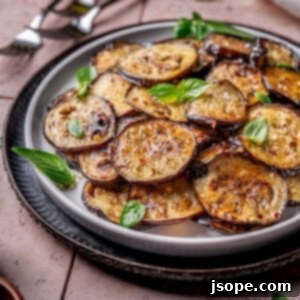
Garlic Herb Sautéed Italian Eggplant Recipe
Equipment
- 1 Large frying pan
Ingredients
- 4 Italian eggplants (small varieties of globe eggplant about 5-7 inches long)
- 6 Tablespoons olive oil (divided, and more as needed)
- 1 teaspoon kosher salt
- ½ teaspoon black pepper
- 2 teaspoons Italian seasoning
- 1 teaspoon garlic powder
- Flaky sea salt for serving (optional)
- Fresh basil (for garnish)
Instructions
Prepare the Eggplant
- Remove the stem and top of the eggplants and slice the eggplants into rounds. We recommend slicing them ¼” thick as the cooking time will be perfect to achieve a caramelized exterior and a creamy interior of each slice.4 Italian eggplants
Sauté and Season the Eggplant
- On medium-high heat, add about 3 tablespoons of olive oil to a large frying pan. Once it heats up, sauté the eggplant in batches. Place some of the rounds in the pan in a single layer and season the top side with a little salt, pepper, Italian Seasoning, and garlic powder. Each side will only take a few minutes. Flip and season the other side in the same manner.6 Tablespoons olive oil, 1 teaspoon kosher salt, ½ teaspoon black pepper, 2 teaspoons Italian seasoning, 1 teaspoon garlic powder
- Once the exteriors get a deep caramel color, remove to a plate and season with a pinch of sea salt if desired. They can be held in a 250°F oven while you finish the remaining rounds. When doing these in batches, you may need to add a little bit more olive oil to the pan as eggplant is extremely absorbent. Serve!Flaky sea salt for serving, Fresh basil
Notes
- Italian Seasoning: Any variety of simple seasonings can be used from anywhere around the world to change the flavor profile of the finished dish.
- Garlic Powder: You can substitute onion powder if desired. Or use both! You can of course use fresh garlic if desired as well.
Storage:
How to store leftover sautéed eggplant: Store cooked eggplant In an airtight container in the refrigerator for up to 5 days.
How to reheat leftover eggplant: The oven is a great way to reheat the eggplant on about 350°F.
Top Tip:
Choose smaller eggplants! For globe eggplants, the larger the eggplant the more bitter they can become. This recipe works with all varieties of eggplant.
Nutrition
Calories: 213kcal
Carbohydrates: 28g
Protein: 5g
Fat: 11g
Saturated Fat: 2g
Polyunsaturated Fat: 1g
Monounsaturated Fat: 8g
Sodium: 591mg
Potassium: 1074mg
Fiber: 14g
Sugar: 16g
Vitamin A: 124IU
Vitamin C: 10mg
Calcium: 59mg
Iron: 2mg
